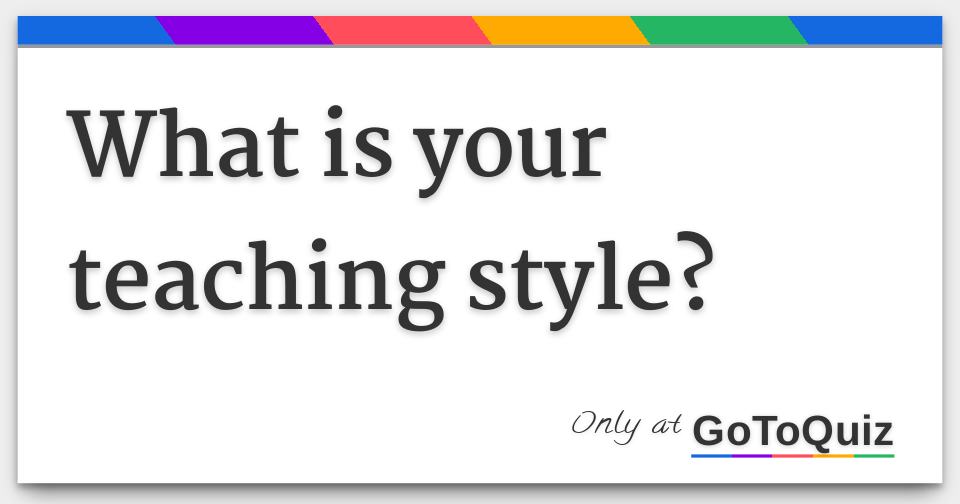Why Teaching Styles Matter

Understanding teaching styles, like learning styles, is part and parcel of being an effective teacher. We thought it suitable to follow up our previous article on learning styles with some similar advice on teaching styles and how to incorporate them into your Udemy course.
Why are teaching styles important to consider as an online instructor? Well if there are a variety of learning styles, then it follows that a variety of teaching styles should be considered to adapt to the various learning styles.
Since many Udemy instructors are not professionally trained teachers, many likely don’t consider theoretical aspects of traditional pedagogy when designing courses – at least not outright. Yet, effective teachers in traditional settings vary their teaching styles depending on the nature of the subject matter, the level and phase of their course, and other factors.
While your choice of teaching style might at first seem limited on Udemy given it’s straight up “canned video” format, you do have some power and choice over how to incorporate different teaching styles.
Generally, there are 5 teaching styles: Authoritative, Delegator, Facilitator, Demonstrator, and Hybrid. We’ll briefly describe each of these and provide some ideas for how you might go about adapting your Udemy course using them.
Authoritative Teaching Style
As the name implies, this is your typical classroom lecture, that is to say, a one-way discussion. Of course, on Udemy, your course is very much a one-way “discussion”. While it is easy to just accept that this is the default teaching style for Udemy instructors, the issue with this style of teaching is that it is very passive and not individualized at all. We would submit that this teaching style is likely why many students never actually complete a Udemy course.
Therefore if your subject matter lends itself to this kind of one way teaching, it can be helpful to soften it up using a few tactics.
For starters, be sure to provide the big picture and some colorful background of whatever it is you are going to be teaching at the beginning of the course and/or any particular lessons. This will help provide motivating context for students as they listen to you “drone on”. Also, be very clear about the end goal and lay out how your lectures and course structure will get students there. Students can use this end goal for motivation to keep watching and listening.
Delegator Teaching Style
This is where the teacher promotes hands-on learning or group learning, effectively stepping out of the teaching role. In a real-life classroom, the teacher asks students to respond to questions and/or talk amongst themselves, which helps with engagement.
While this teaching style is very difficult to incorporate on Udemy, you can nevertheless simulate this to a certain extent. You can offer an online discussion forum like a Facebook group for students to join and learn from each other. Have them follow you and subsequently each other on Twitter and other social media.
You can assign hands-on projects. In fact, you should do this for many reasons, namely so that your students have tangible proof of learning outcomes. One such idea would be to assign a research project that relates to some real-life aspect of your students’ lives, such as their workplace or profession, that encourages interaction with others.
Facilitator Teaching Style
This style encourages self-learning and asks students to engage in questioning, problem solving and self-discovery, rather than the teacher providing all the answers and information. This style would be used to counteract the Authoritative teaching style. And because this teaching style encourages self-learning, which clearly suits anyone taking a Udemy course, it is appropriate to consider in the context of designing a Udemy course.
Although your ability to facilitate actual student self-learning is limited on Udemy, you can encourage real-time question-asking by encouraging students to contact you with specific questions and ideas, and then actively engaging and replying to these.
You can also provide them with suggested exercises and case studies that encourage self-discovery and additional self-learning or questions to ponder. Encourage them to familiarize themselves with resources available in their community or elsewhere online such as online educational websites. Challenge them to solve open-ended problems and contact you with their solutions for feedback.
Demonstrator Teaching Style
As a Udemy instructor, you are naturally engaging in many facets of this teaching style. As the name implies, you are lecturing but supporting your lecture with other forms of teaching such as visuals, how-to demonstrations, screencasts, and other multi-media presentations.
If you are teaching music, art/crafts, physical activity/education such as dance, or cooking, you should be adopting this style. The key though to remember is that you are maintaining authority and not engaging students while demonstrating.
So try to incorporate some non-authoritative dialogue into your demonstrations. For instance, encourage students to do some experimentation outside of what you are showing them, suggest opportunities to try new things, make suggestions for further activity and self-discovery and so forth. This way, while you are demonstrating with authority, you can keep students engaged in the learning picture.
Hybrid Teaching Style
This teaching style is probably the least useful on Udemy because it implies that you adapt your teaching style real time to individual student needs in the classroom. But another aspect of this teaching style does apply.
In this scenario you incorporate your own personality, preferences and interests heavily into your teaching style. Again, many Udemy instructors will do this quite naturally, especially if you are teaching a favorite hobby or professional interest. What this teaching style essentially means is that you are imparting a deeper level of knowledge and understanding to your students because you, yourself are so deeply immersed in what you are teaching.
The risk here is that you try to impart too much information about too many things to appeal to a wide range of learners – think one course addressing beginner to advanced level knowledge. The end result is that learning is diluted.
What’s Your Teaching Style?

While you will not be able to invoke these teaching styles in the traditional sense, you can nevertheless enhance your course design, content and script by keeping in mind these various approaches and thinking about how they can be emphasized in your Udemy teaching approach. Why not experiment a little with these in your course over time and see how your learners react and what feedback you get?
Much has been written and researched on how to assess what your teaching style is. If you are curious, here’s two popular tools for assessing which of the teaching styles is closest to your natural instructional method:

